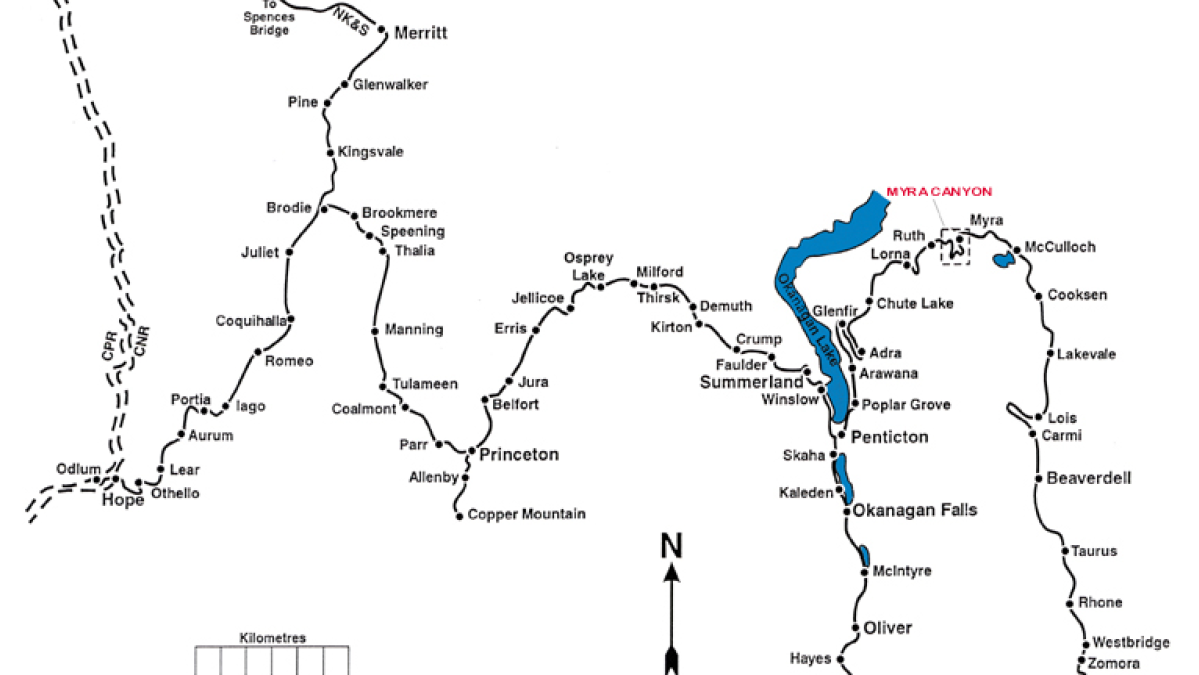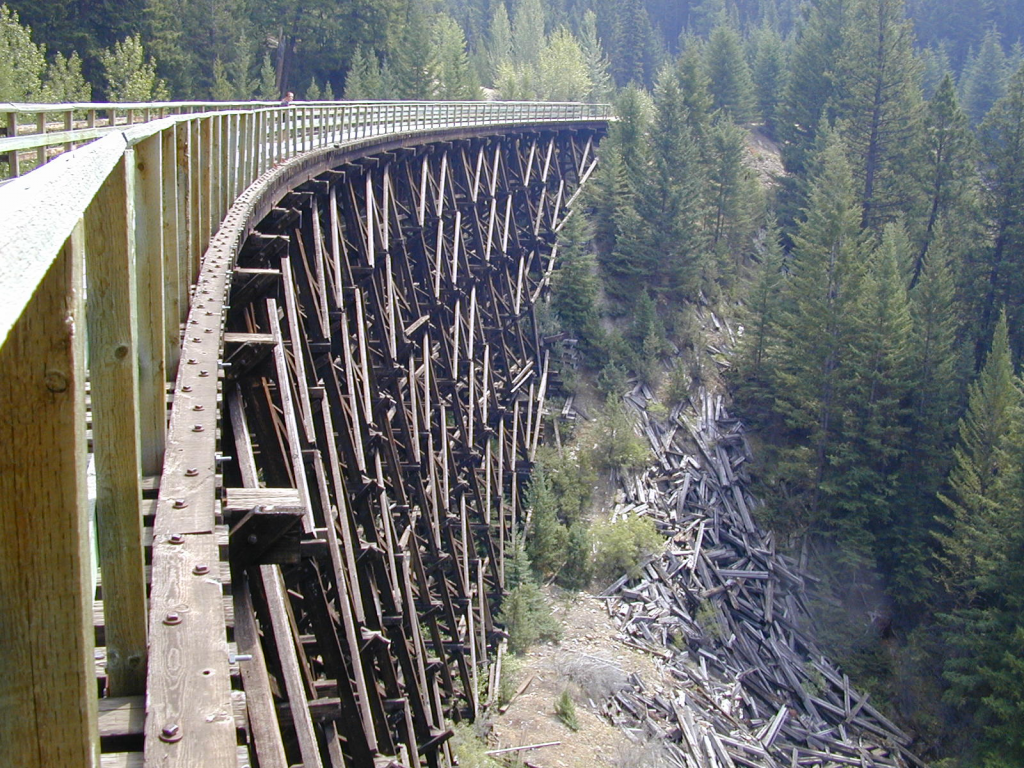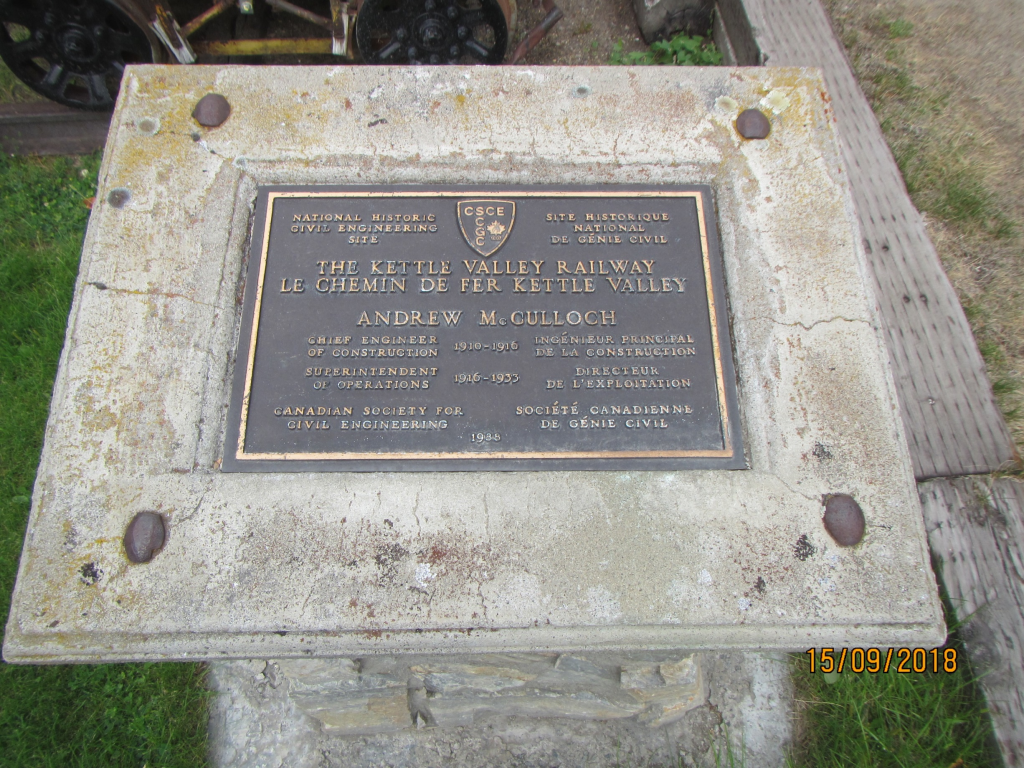The Kettle Valley Railway, Midway, BC.

Site Location: Lat.: 49° – 0’ – 40” N.; Long.: 118° – 47’ – 9” W. (GPR: 49.0111244, -118.7857312). Kettle River Museum, Midway, BC. From the east, from Trans-Canada Highway 1 take BC Highway 97A south at Sicamous for 65.5 km to where it becomes BC Highway 97/Okanagan Highway, north of Vernon. Continue south on BC 97 for 52.1 km to Kelowna, exiting on to go east on Old Vernon Road. Proceed 0.3 km and turn right (south) on Rutland Road and, after 3.3 km, turn left (east) on the Kelowna-Rock Creek Highway, BC 33. Proceed 126 km to Rock Creek, and continue straight on BC Highway 3 east 18.3 km. From the west: from Trans-Canada Highway 1 at Hope, take BC Highway 3 east for 873 km. The museum is on the north side of BC Highway 3.
Plaque Location: The plaque is mounted on a rock cairn at the Kettle River Museum, along the pathway to the reconditioned Midway Station and Canadian Pacific Railway caboose.

Description: The Kettle Valley Railway was a 500 km (310 mi.) rail system with a main line between Hope and Midway, BC, with branch lines to Spences Bridge, Copper Mountain , and Osoyoos. It traversed three mountain ranges and so was famous for its bridges, tunnels and snowsheds. Andrew McCulloch served as the Chief Engineer between 1910 and 1916 and continued until 1933 as Superintendent of Operations.
The Kettle Valley Railway constructed most of the main Hope-Midway line between 1911 and 1915. The Vancouver Victoria & Eastern Railway built the Princeton to Brookmere section between 1911 and 1914. The branch to Merritt was completed in 1911 and connected to an existing line to Spence’s Bridge. The branch to Copper Mountain was completed in 1920. The branch to Oliver was completed in 1923 and pushed on to Osoyoos in 1944. The Canadian Pacific Railway took control of operations in 1931 and incrementally abandoned the main and branch lines between 1961 and 1990.
The construction through the Coquihalla Canyon features the five collinear Othello-Quintette tunnels and two bridges. The section between Penticton and Midway required 18 wooden trestles and two tunnels to traverse the deep Myra Canyon. This section was designated a National Historic Site of Canada in 2002. Twelve of the trestles were destroyed in the Okanagan Park Fire in 2003 and have since been rebuilt.
The Kettle Valley Steam Railway operates along a 10 km section near Summerland, BC. The Kettle Valley Railway right-of-way is now part of the Trans Canada Trail.


Historic Significance: The decision by the Canadian Pacific Railway to follow a northern route through the Kicking Horse and Rogers Passes and down the Fraser canyon to Vancouver left southeastern British Columbia isolated. The discovery of silver in this region in 1887 triggered a large influx of American miners who shipped the ore to Washington ports, on J. J. Hill’s Great Northern Railway. The Kettle Valley Railway was therefore constructed to maintain Canadian sovereignty and transport ore extracted from the Kootenay, Boundary and Similkameen areas to Hope and so by the CP rail line to Vancouver. Canadian Pacific Railways assumed formal control of the system in 1931 and, until 1959, used it when washouts, avalanches or rock slides closed the main CPR line.
Andrew McCulloch (1864-1945) graduated from Kingston’s Dominion Business College in 1888 and immediately moved to the West Coast, finding work as an axeman on J. J. Hill’s Great Northern Railway. He subsequently worked as Resident Engineer for the construction of the Lake Superior and Ishpeming Railway, on the Nakusp and Slocan branch line, the CPR’s Crow’s Nest Line, the Columbia and Western, and the Grand Trunk Pacific. He returned to the CPR as Divisional Engineer of Construction, Eastern, based in Montreal, before he was appointed Chief Engineer for the Kettle Valley Railway. McCulloch was an avid reader of Shakespeare and had a role in naming other Coquihalla Subdivision stations after Shakespearean characters Iago, Romeo, Juliet, Lear, Jessica, and Portia.

Plaque Wording: CSCE. National Civil Engineering Historical Site. THE KETTLE VALLEY RAILWAY. ANDREW McCULLOCH, Chief Engineer of Construction 1910 – 1916. Superintendent of Operations, 1916 - 1966. Canadian Society for Civil Engineering. 1988.
SCGC. Site Historique National de Génie Civil. LE CHEMIN DE FER KETTLE VALLEY. ANDREW McCULLOCH, Ingénieur Principal de la Construction, 1910 – 1916. Directeur de L’Exploitation, 1916 – 1933. Société Canadienne de Génie Civil. 1988.
Links to Online Documentation: